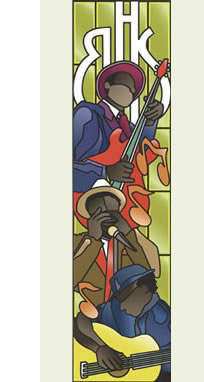Friday,
October 13th
Saturday, October 14th, 2006
|
Blue Heaven
Studios
201 S. Eighth Street
Salina, Kansas 67401
785-825-8609 |
Grayson Capps
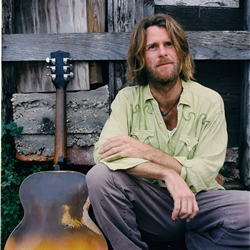 Grayson Capps descends
from the celebrated American
Southern literary tradition,
and his songs deal with
the South and the idiosyncrasies
of its people, landscapes
and tempos. Recently
selected by Razor
Magazine as one
of five artists to watch
in 2005, writer Bret
Love declared: "Like
a whiskey-soaked, back
alley poet sired by Tom
Waits and Robert Johnson,
Capps' stripped-down
sound is rooted in the
dark side of the Delta." Grayson Capps descends
from the celebrated American
Southern literary tradition,
and his songs deal with
the South and the idiosyncrasies
of its people, landscapes
and tempos. Recently
selected by Razor
Magazine as one
of five artists to watch
in 2005, writer Bret
Love declared: "Like
a whiskey-soaked, back
alley poet sired by Tom
Waits and Robert Johnson,
Capps' stripped-down
sound is rooted in the
dark side of the Delta."
Capps, 39, narrowly missed what looked like the big-time in the early '90s. His
band, then called the House Levellers, gathered some fame, including a spot on
the cover of USA
Today and opening tour slots for Crowded House, before tensions
drove the group into the ground.
After that, Capps discovered
a stretch of houses on
the railroad tracks off
Tchoupitoulas St. in
New Orleans, where he'd
graduated Tulane University
a few years prior. He
lived there like a bit
of a squatter for a few
years, sharing electricity
with other shotgun apartments
and illegally tapping
the city's water main
and gas line. It was
a time for wood shedding – writing
songs and playing guitar.
Eventually, he and another musician from his makeshift beatnik community formed
the group Stavin' Chain and ascended to the point where they jammed with Ron
Wood of the Rolling Stones, opened for the Wallflowers, Koko Taylor and Jeff
Buckley and were finally signed to Ruf Records and distributed by Polygram Records.
But just as success seemed inevitable, Polygram merged with Universal and dropped
their record. The band broke up.
Capps then stumbled into a movie role. He'd met an independent film producer
who'd told him of her desire to make a film about New Orleans. Turns out, Capps'
father had written an unpublished book that took place in New Orleans and told
the tale of Bobby Long and Fred Stokes. The producer loved the book, turned it
into a screenplay and asked Capps to join the cast, which also includes John
Travolta, and contribute music to the soundtrack. A
Love Song For Bobby Long was released in 2004.
Chick Willis
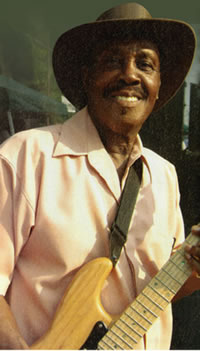 "The Stoop Down Man," as he's called, is a true triple threat: a superb guitarist, a soulful singer and one hell of an entertainer. Robert "Chick" Willis, 72, is of course best known for his 1972 raunchy, good-humored insult ode, "Stoop Down Baby Let Your Daddy See." The song was a major jukebox hit, though the lyrics were a little too risqué for
radio
airplay.
All
the
same,
the
record
sold
over
three
million
copies
and
put
Willis
on
the
map
to
stay. "The Stoop Down Man," as he's called, is a true triple threat: a superb guitarist, a soulful singer and one hell of an entertainer. Robert "Chick" Willis, 72, is of course best known for his 1972 raunchy, good-humored insult ode, "Stoop Down Baby Let Your Daddy See." The song was a major jukebox hit, though the lyrics were a little too risqué for
radio
airplay.
All
the
same,
the
record
sold
over
three
million
copies
and
put
Willis
on
the
map
to
stay.
But Willis had been thrilling audiences for more than a decade before that song,
and he'd worked as a sideman since he was a teen growing up in Atlanta. His first
professional gigs came at the Royal Peacock Club, where he backed such talent
as Jimmy Reed, Ray Charles, Sam Cooke and Big Joe Turner. He went on the road
with his cousin, famous blues ballad singer Chuck Willis, in 1954. In 1956, Willis
made his first recordings under his own name for the Los Angeles-based Ebb Records.
When Chuck died in 1958, Willis stopped in Chicago and backed Elmore James for
a stretch.
In
the
early
'60s,
Willis
cut
a few
obscure
sides
for
small
labels.
But
with "Stoop Down Baby," released
on
the
La
Val
label,
he
hit
on
a number
so
requested
and
memorable
that
he
solidified
gigs
all
the
way
into
the
present
day.
But he hasn't rested on the laurels of that song. Willis has gone on to record
11 more records since, and he's toured the world multiple times. In the 1980s,
Willis lived in Kansas City, where he owned and operated Blues Alley, at 39th
and Jackson on the Missouri side. He's since moved back to his hometown Atlanta.
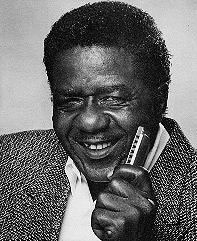 Willie
Cobbs Willie
Cobbs
In 1960, Willie Cobbs cut a tune with a
melody so catchy and memorable that it eventually sounded just
like a cash register ring. "You Don't Love Me," covered to enormous
success by the Allman Brothers Band and later Dawn Penn of Jamaica,
immortalized Cobbs in the scope of blues songwriting.
Born in Monroe, Arkansas in 1932, Cobbs
was turned off by the prospect of rice farming and migrated
to Chicago in 1947. He learned the harmonica, and soon began
an association with noted piano player Eddie Boyd. The two
of them returned to Arkansas together and took up gigs around
the town of Hughes. It's there that Cobbs wrote and began
performing "You Don't
Love Me." The local audiences went wild.
"Every time we played it, the people would come
back around and say, 'Play that again! Play that again!'," Cobbs
recalled. "They'd
say, 'Y'all need to record that.'"
And so Cobbs set off for Memphis in 1960 to
do just that. He went to the city's biggest record store, The
Home of the Blues, and performed the song for the storeowner,
who also had a record label.
"He said, 'It's a damn good song, but you can't
sing.'," Cobbs
said, laughing now at the memory. "He said, 'I can probably
get Howlin' Wolf to sing it, but you can't sing it."
Cobbs walked out the door disappointed. But
Billy Lee Riley and Stan Kessler, two local musicians and producers,
happened to be in the store and had heard the performance.
They followed Cobbs out of the store struck an agreement on
the spot to record the song.
Just a couple days later, Cobbs and Boyd, along
with a saxophonist, guitarist and bassist cut the song for
Riley's Mojo label. It instantly became a smash, quickly rising
to Number One in Memphis.
Kessler and Riley sold the master to Reuben
Cherry, the same Home of the Blues storeowner who originally
rejected Cobbs. Cherry leased it to Vee-Jay out of Chicago.
But at the same time, Riley took the tune to a group in Louisiana
called the Megatons and cut an instrumental version titled "Shimmy
Shimmy Walk, Pt. 1." Riley credited himself as composer. "Shimmy
Shimmy Walk, Pt. 1" started to climb the charts on the Checker
label, but Cobbs sued Riley. Vee-Jay, scared off by the lawsuit,
ceased pushing "You Don't Love Me."
Fortunately for Cobbs, you can't keep a good tune down. The
Allman Brothers covered the song on their 1971 Live at
Fillmore East, and Dawn Penn adapted the tune to a reggae
beat on her No No No album in 1994. Both versions
became massive hits, and Cobbs has pocketed hundreds of thousands
of dollars in royalties.
In the '60s, '70s and '80s, Cobbs recorded for
a slew of obscure labels, many of them his own. While he hasn't
scored any more hits, he is recognized as a phenomenal performer
and remains in-demand worldwide.
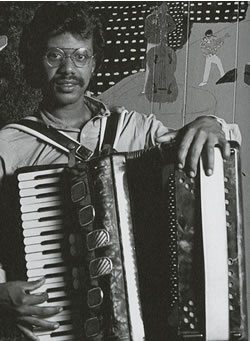 Leon Sam Leon Sam
Clifton
Chenier popularized the good-time, accordion-driven music called
Zydeco in the 1950s. And ever since, Zydeco bands have spread
from southern Louisiana like Bermuda grass. But as the music's
aged and evolved, it's changed generally from a blues-based
genre into one set to hyper-tempo rock rhythms, played loud.
There are very few remaining of the original-styled, "real" Zydeco
artists, playing the music the way Chenier did. Leon Sam is
one of those few.
Sam, who is from Houston, learned Zydeco from his father, Herbert Sam, who led
a band for many years. Herbert taught each of his children an instrument, and
as they became proficient, each one joined the band. Finally, when all of Herbert's
sons - Leon, Carl, Glen, Calvin and Rodney - were experienced musicians, Herbert
retired from music and let his boys take over. They became The Sam Brothers Five,
and Leon assumed the accordion, vocal and bandleader roles. The group went on
to become one of the most electrifying bands on the Zydeco circuit.
Arhoolie Records producer Chris Strachwitz discovered Leon and his brothers at
the New Orleans Jazz and Heritage Festival in 1979. Strachwitz organized a west
coast tour for the group, recorded a live performance and released the group's
debut LP, Sam Brothers 5. Cruisin' On came in 1981, followed
by Zydeco Brotherhood in 1989.
Paul "Lil' Buck"
Sinegal (performing with Willie Cobbs and
Leon Sam)
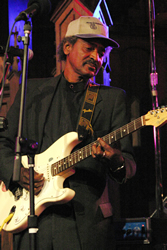 At
age 62, Lil' Buck Sinegal’s career has
spanned more than four decades with over 300 recordings,
including Grammy-winning efforts with Paul Simon's
1987 album Graceland. He's also performed
and recorded with Clifton Chenier, Rockin' Dopsie,
Buckwheat Zydeco, Fernest Arceneaux and Barbara Lynn. Sinegal
has recorded several albums as a bandleader and in 1999
was inducted into the Louisiana Blues Hall of Fame. He
is making his fourth Blues Masters appearance. At
age 62, Lil' Buck Sinegal’s career has
spanned more than four decades with over 300 recordings,
including Grammy-winning efforts with Paul Simon's
1987 album Graceland. He's also performed
and recorded with Clifton Chenier, Rockin' Dopsie,
Buckwheat Zydeco, Fernest Arceneaux and Barbara Lynn. Sinegal
has recorded several albums as a bandleader and in 1999
was inducted into the Louisiana Blues Hall of Fame. He
is making his fourth Blues Masters appearance.
Lee Allen Zeno (performing
with Willie Cobbs and Leon Sam)
So often, sidemen don't get proper credit for their place
in helping to create historic music. But you can tell the
good ones by recognizing on how many records by how many
different artists their names turn up. Lee Allen Zeno is
as in-demand a bass player as any. His credits include recordings
with Buckwheat Zydeco, Charlie Rich, Dalton Reed, Guitar
Shorty, Solomon Burke, Carol Fran, Phillip Walker, Marcia
Ball, Irma Thomas, The Holmes Brothers and Carl Weathersby.
Syl Johnson
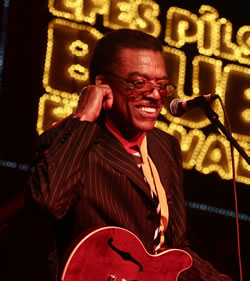 One
of the greats from the fabled Hi Records stable, Syl Johnson
is a classic soul singer and an accomplished guitarist.
His singing style might be described as a cross between
Joe Tex and James Brown though Johnson's inspired the
voices of many more artists than he's mimicked. One
of the greats from the fabled Hi Records stable, Syl Johnson
is a classic soul singer and an accomplished guitarist.
His singing style might be described as a cross between
Joe Tex and James Brown though Johnson's inspired the
voices of many more artists than he's mimicked.
Johnson was born July 1, 1936 in Holly Springs, Mississippi
as Sylvester Thompson. His brothers include blues guitarist
Jimmy Johnson and bassist Mac Thompson. He moved to Chicago
as a young man and soon found jobs accompanying Magic Sam,
Billy Boy Arnold, Junior Wells, Elmore James, Willie Dixon,
Shakey Jake and Howlin' Wolf. Johnson made his recording debut
in 1959 backing Jimmy Reed for the Vee-Jay label, and he scored
his own deal for Federal that same year, cutting a 45 using
Freddie King as lead guitarist.
After the Federal singles failed to hit,
Johnson began recording for Twilight Records (later Twinight)
of Chicago. He scored his first hit with Twilight in 1967
with "Come On Sock
It To Me" and hit again in '69 with "Is It Because
I'm Black."
Dresses Too Short, one of Johnson's
Twinight releases, was cut in Memphis with Willie Mitchell
of Hi Records as producer. Mitchell fell in love with the
uniquely expressive qualities of Johnson's singing and in
1971 brought him to Hi, one of the jewels of the Memphis
soul and R&B labels. Hi had become
a huge label thanks to the success of Al Green, and Johnson
reached number seven on the R&B charts with his cover of
Green's "Take Me To The River" in 1975. Johnson's
star was born on the Hi label from 1972 to 1976.
After the Hi years, Johnson produced two LPs for his own Shama
label, the latter of which (Ms. Fine Brown Fame) in
1982 was picked up for distribution by Boardwalk Records and
produced his last hit, the title cut. Soon after, Johnson dropped
out of the music business and opened Solomon's, a chain of
fast-food fish restaurants in Chicago.
In the late 1980s and early '90s, various rappers,
including Ice Cube, Ice-T, NWA, Public Enemy, Tone-Loc, MC
Hammer and the Wu-Tang Clan, began sampling Johnson' classic
1960s and 70s recordings, and he began to receive substantial
royalty checks. The attention prompted Johnson's return with
1993's Back
In The Game for the Delmark label. He's recorded six more
albums since.
Saturday,
October 14
Jimmy McCracklin
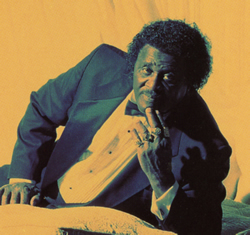 Jimmy McCracklin, at 85 years old, performs with the life of someone at least
10 years his junior. Maybe it's because that's what he is. All the documents
have McCracklin born in August of 1921, but he vehemently denies his reported
age, saying he's 75 years old. In any case, 85 or 75, McCracklin defies all expectations
but his own with rousing performances of his big-time hits. Jimmy McCracklin, at 85 years old, performs with the life of someone at least
10 years his junior. Maybe it's because that's what he is. All the documents
have McCracklin born in August of 1921, but he vehemently denies his reported
age, saying he's 75 years old. In any case, 85 or 75, McCracklin defies all expectations
but his own with rousing performances of his big-time hits.
McCracklin began recording in 1945 (could he really have
been just 14?) after he'd served a stint in the Navy during
World War II (as a pre-teen?). He'd also worked for a short
while as a successful boxer. But eventually he moved from
his native St. Louis to the West Coast and recorded "Miss Mattie Left Me" for
the Globe label in 1945.
McCracklin went from Globe to a series of small-time labels
before finally landing in the major leagues with Modern
in 1949, Swing Time the following year and then Peacock
from 1952 to 1954. Later in '54, he was back with Modern
and scored a hit with "Couldn't Be A Dream." But his first major hit came with "The Walk," a raw dance tune with a catchy groove. McCracklin recorded "The Walk" in 1956 for the Irma label, but the hit came in 1958 when it was issued on Checker (the sister label to Chess). The song rose to the Top 10 on both pop and R&B
charts, and in a flash McCracklin became famous. He reportedly
was the first blues artist to appear on Dick Clark's American
Bandstand TV show.
More hits came in the way of "I Just Got To Know" in 1961 and "Shame, Shame, Shame" the following year, both songs for the Art-Tone Records. He moved labels yet again, this time to Imperial, and hit with "Every Night, Every Day" in 1965 and "Think" and "My Answer" in 1966. McCracklin also wrote "Tramp" in 1967 for his buddy Lowell Fulson, who took the tune to the top of the R&B
charts. The songs climbed even higher when Otis Redding
and Carla Thomas covered it just a few months later.
McCracklin represents one of the very last of the Jump Blues piano players from
the West Coast tradition.
Rory Block
 "Rory Block is one of the greatest living acoustic blues artists, and she can hold her own with the legends who inspired her." – Blues
Revue "Rory Block is one of the greatest living acoustic blues artists, and she can hold her own with the legends who inspired her." – Blues
Revue
Heralded as "a living landmark" (Berkeley
Express) and "a national treasure" (Guitar
Extra), Block is a traditionalist and an innovator at the same time. The
New York Times declared: "Her
playing is perfect, her singing otherworldly as she wrestles
with ghosts, shadows and legends."
Born in Princeton, New Jersey in November 1949, Aurora "Rory" Block grew up in Manhattan in a family with Bohemian leanings. Her father owned a Greenwich Village sandal shop, where musicians like Bob Dylan, Maria Muldaur and John Sebastian all made occasional appearances. She was playing guitar by age 10, and by her early teens she was sitting in on the Sunday jam sessions in Washington Square Park. During these years, her life was touched – and profoundly changed – by
personal encounters with some of the earliest and most influential
Delta blues masters of the 20th century. She learned her
first lessons in blues and gospel music from the Reverend
Gary Davis, Son House, Skip James and Mississippi John Hurt.
Block recorded an instructional record called How
To Play Blues Guitar in the mid-60s (she was billed as
Sunshine Kate on the original recording) but then took a decade
off from music to start a family. In the 1970s, she made a
few records that ran counter to her inherent blues instincts,
and the result was frustration. Returning to the blues, she
signed with the Boston-based Rounder label and released High
Heeled Blues in 1981. Rolling
Stone referred to the album as "some of the most singular
and affecting country blues anyone – man or woman, black or
white, old or young – has
cut in recent years."
In the 1990s, Block brought home W.C. Handy Awards four years
in a row – two
for Traditional Blues Female Artist of the Year and two for
Best Acoustic Blues Album of the Year. She joined the Telarc
label in 2003 and has since released two acclaimed records, Last Fair Deal and From the
Dust.
Diunna Greenleaf
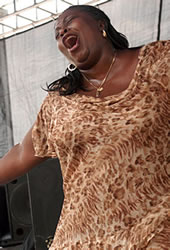 Diunna Greenleaf, of Houston, Texas, has a background steeped
in both blues and gospel. She's been influenced by the likes
of Koko Taylor, Aretha Franklin, Rosetta Thorpe, Sam Cooke
and Charles Brown, and she includes intricate patches of jazz
and soul in her performances. Diunna Greenleaf, of Houston, Texas, has a background steeped
in both blues and gospel. She's been influenced by the likes
of Koko Taylor, Aretha Franklin, Rosetta Thorpe, Sam Cooke
and Charles Brown, and she includes intricate patches of jazz
and soul in her performances.
Greenleaf came to the life of professional performing quite
late, considering how much talent she had to offer. She worked
as a school counselor and occasionally sang rather informally
for children's and educational benefits. She and her band
played a small show at a hospice in celebration of Houston
blues legend Teddy "Cry Cry" Reynolds' birthday. Afterwards,
Reynolds told Greenleaf of how he'd known her parents, both
gospel musicians, and how she was not only very talented but
also had a duty to continue the family legacy of performing.
So insistent was Reynolds that he solicited the opinion of
his old friend Katie Webster, the Swamp Boogie Queen. Webster
confirmed Reynolds' assessment and encouraged Greenleaf to
seriously pursue a life in music, even giving her newfound
protégé typed
rules for forming and leading a band.
In 2005, Greenleaf and her band Blue Mercy represented Houston
in the International Blues Challenge, an annual contest in
Memphis that features the world's best unsigned blues bands.
Greenleaf and Blue Mercy finished first out of 84 bands from
32 states and eight countries. What's more, Blue Mercy's guitarist,
John Richardson, earned the Albert King Award for Most Promising
Guitarist. From there, the gigs came steadily, and the group's
been booked solid ever since.
Greenleaf has performed with Blues Masters alumni Bob Margolin,
Pinetop Perkins, Hubert Sumlin, Willie "Big Eyes" Smith,
Carey Bell, Mookie Brill as well as with other greats like
James Cotton, Keb' 'Mo, Anson Funderburgh, Sam Meyers, Bernard
Allison, Odetta, Sherman Robertson and Kenny Neal.
Blues Revue named Greenleaf in their 100th anniversary feature 10
To Watch: The Future of the Blues in July of this year.
Phillip Walker
 Phillip Walker has been on the road almost continuously for
53 years. He started out backing some of the all-time greats
and eventually became one himself. Phillip Walker has been on the road almost continuously for
53 years. He started out backing some of the all-time greats
and eventually became one himself.
Born in Welsh, Louisiana in 1937 to sharecropping
parents, Walker and his family moved to Port Arthur, Texas
when he was 8. His formal education ended when he was just
12 after his father became ill and his hands were needed fulltime
in the fields. Walker had several uncles who were guitarists,
and they exposed him to the instrument at a very young age.
He fashioned his first model using a cigar box and window screen
wire.
When he was just 15, Walker began to wear a fake mustache
to gain entry into the local taverns where he sat in with performing
bluesmen. Later that year of 1952, he made his recording debut
as a sideman for Rosco Gordon. The following year, he met and
played with Clifton Chenier when the King of Zydeco passed
through Port Arthur. Chenier invited Walker to join his band,
and against his parents' wishes, the 16-year-old set out on
the road.
By 1955, the still-teenaged Walker was already a veteran sideman
who'd worked in Chenier's band for a couple of years and had
also backed Little Richard and Etta James. He formed his own
band, the Blue Eagles, and toured the country as accompaniment
for Little Richard and Fats Domino.
Walker relocated to Los Angeles for good beginning in 1959,
and he soon met singer Ina Beatrice Gilkey, known as Bea Bopp.
The two worked together throughout the '60s and eventually
married.
In 1973, Walker recorded his first solo album with The
Bottom Of The Top for Hugh Hefner's short-lived Playboy
label. The record sold well and scored very solid acclaim,
putting Walker in even greater demand. He followed with Someday
You'll Have These Blues in 1976 on the Joliet label,
which again served notice that Walker had become a dominant
force on the blues scene. He began to score major festival
spots worldwide.
Walker's wife Bea Bopp died of lung cancer in 1991, though
she'd never smoked. Distraught as he was, Walker continued
to tour and record to pay the bills. He cites his late wife
as his chief inspiration.
Walker's remained incredibly active and focused and has by
this point played every major festival worldwide. Since 1985,
he's recorded for Hightone, JSP, Black Top and Alligator.
T-Model Ford
 T-Model Ford was born James Lewis Carter Ford in Forrest, a
small community in Scott County, Mississippi. Ford thinks he's
84 but isn't sure. He was plowing a field behind a mule on
his family's farm by age 11, and in his early teens he secured
a job at a local sawmill. He excelled and was later recruited
by a foreman from a bigger lumber company in the Delta, near
Greenville, and eventually got promoted to truck driver. He
later worked in a log camp. Ford didn't take to music until
he was in his 50s and his then-wife (number five) bought him
an electric guitar and amplifier for his birthday. By the next
week, she'd left him, and that's when he began to study seriously
on his new instrument. T-Model Ford was born James Lewis Carter Ford in Forrest, a
small community in Scott County, Mississippi. Ford thinks he's
84 but isn't sure. He was plowing a field behind a mule on
his family's farm by age 11, and in his early teens he secured
a job at a local sawmill. He excelled and was later recruited
by a foreman from a bigger lumber company in the Delta, near
Greenville, and eventually got promoted to truck driver. He
later worked in a log camp. Ford didn't take to music until
he was in his 50s and his then-wife (number five) bought him
an electric guitar and amplifier for his birthday. By the next
week, she'd left him, and that's when he began to study seriously
on his new instrument.
Ford released his debut record, Pee Wee Get My Gun, on the Fat Possum
label in 1997 at the age of approximately 75. The record's style fit perfectly
with the burgeoning Fat Possum sound - that being raw, bare, repetitive, hard-living-inspired
country blues. Ford is a sure-fire poster child for that sub-genre. As Blues
Revue commented in 2005, "From an abusive father to time on a 1940s
chain gang, from five failed marriages to his newfound fame as a bluesman, T-Model
has ducked and dodged when he could and fought when he couldn't." Ford followed
his debut with three more records for Fat Possum, the most recent being Bad
Man in 2002.
Ford is the only man still playing on Greenville's
Nelson Street. Most of the audience has scattered due to violence
from the crack trade, and with the exception of Ford, the
street that once boasted Booba Barnes is dead. On a typical night,
Ford will arrive at the club and unpack his instruments.
When he feels there are enough people, he starts banging away
in his own hill stomp. It's nothing unusual for him to play
eight hours a night. He keep going until no one's left standing. |


